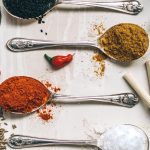There was a time when eating local was the only option. Who knew that Queen Isabel’s decision to send Columbus to explore the world would have such a great impact on what we eat today? Before the “discovery of the Americas” there was no chocolate in Switzerland, no coffee in South America, Ireland did not imagine how important a potato would be, Thailand did not know what chili tasted like, and Italy knew nothing about tomatoes.

Since then food trade has become a mainstay industry, and has brought a huge diversity of foods to our tables around the world — but how much is enough? When does food globalization and having so many options starts affecting the quality of our environment and therefore our health?
THE IMPORTANCE OF SUSTAINABILITY
Sustainable eating is important to all of us because it means that you and the generations to come will have healthy and affordable foods in both the short and the long term. The way in which this food is produced will also allow the planet to continue supporting our lives for those who come after us.
It’s no longer enough to just eat healthy. Due to issues like global warming, the increased demand for food, pollution, obesity and other chronic degenerative diseases and rising inequality between individuals and countries, a momentous shift to sustainable eating is required to stop a greater damage to our planet and our health.
One great way you can make a difference is by increasing your consumption of local foods and decreasing your intake of imported foods. Check these case studies to see the other side of the coin of what happens when you think you are eating healthy by consuming non-local foods and what you could help avoid if you eat local:
CASE STUDY 1: QUINOA
1. Increase in price
The popularity, value and production of superfoods like quinoa have increased exponentially in recent years. According to research, between 2000 and 2008, the price at which quinoa was sold at the international market increased by 600%. By 2013 that price had tripled.
2. Increase in obesity and social inequalities
A greater demand for foods such as quinoa in high-income regions like Europe, the US, China and Japan has resulted in increased exports from Andean countries like Peru and Bolivia where quinoa was originally grown. As a consequence, traditional crops are being taken away from the local people. Having once formed part of the basic Andean diet, quinoa now represents an economically inaccessible food that has been converted from traditional local consumption to export. As a replacement for quinoa, the locals have no option but to eat junk food, rice and pasta, which is now much cheaper. In consequence the existing problem of starvation in these countries is now compounded by severe malnutrition.
3. Decrease in biodiversity
When demand for imported foods increases, the conditions and habitats in which these foods are grown have to be modified in order to satisfy that demand. In the case of quinoa, farmers have been forced to use the habitats of endangered species for farming, further threatening these animals’ survival.
CASE STUDY 2: FISH

Many dietitians and nutritionists recommend at least two portions of fish a week. The demand for oily fish like salmon and tuna has gone up so much that the world’s oceans are beginning to run out of fish.
According to The European Commission 40% of fish and seafood consumed in the EU are imported from faraway waters such as the West African coast. Countries like Senegal and The Gambia depend on fish as a main source of dietary protein.
By taking tens of thousands of tonnes of local seafood away, the local economies (not strong to being with) are further weakened, and local health is greatly affected. This practice impoverishes African fishermen and their families, deprives the local population of food and threatens the viability of marine ecosystems and their fisheries on the narrow continental shelf.
CASE STUDY 3: MEAT
It’s been estimated that the world’s cattle consume enough food to sustain 9 billion people — that’s more than the world’s human population! In Europe, people eat 85 kg of meat per year, and consume 70% more than the amount of protein recommended by nutritional guidelines. The meat industry has one of the highest environmental footprints due to its high usage of water and emissions of carbon dioxide.
WHAT CAN WE DO INSTEAD?
These days we have so much to choose from that we forget about the great availability and richness of local foods that are already on our doorstep!
For example, quinoa may deliver a complete protein (all of the amino acids you require) in a compact package, but it’s not the only way to obtain all your required amino acids. For example, having a rice and bean side dish actually has more health benefits. Find out your local grains and pulses and combine them for greater nutrition.
In the case of fish, look for alternatives rich in omega-3. Research from University College London indicates cultivated algal oils are a good alternative to imported fish, and they’re free of contaminants while satisfying ethical considerations. Other sources include plants such as purslane, linseed or horta, which can taste delicious steamed with lemon and olive oil.
As for meat, the evidence is clear: we need to decrease our meat consumption. Replacing meat with local pulses, grains, nuts and other sources of local protein is your key to a healthier version of you and the environment.
SETTING SUSTAINABLE DIETARY GUIDELINES

The Brazilian health officials set the example by recently publishing revolutionary new dietary guidelines that not only our biological needs but also those of the environment. They’re also incredibly practical:
10 SUSTAINABLE DIETARY GUIDELINES
- Prepare meals from local staple and fresh foods.
- Use oils, fats, sugar and salt in moderation.
- Limit consumption of ready-to-consume food and drink products.
- Eat regular meals, smaller portions, and in environments that will increase mindfulness.
- Avoid eating alone whenever possible.
- Shop at places that offer a variety of fresh foods. Avoid those that mainly sell products ready for consumption.
- Develop, practice, share and enjoy your skills in food preparation and cooking.
- Plan your days to give meals and eating proper time and space.
- When you eat out, choose restaurants that serve freshly made dishes. Avoid fast food chains.
- Be critical of the commercial advertisement of food products.
When you buy and consume something it’s as if you were granting your vote to continue its sale and production. What you decide to eat today can make a difference on global warming, the food economy and our global health. This week, try implementing at least one of these ideas to start the shift from healthy eating to sustainable healthy eating.













